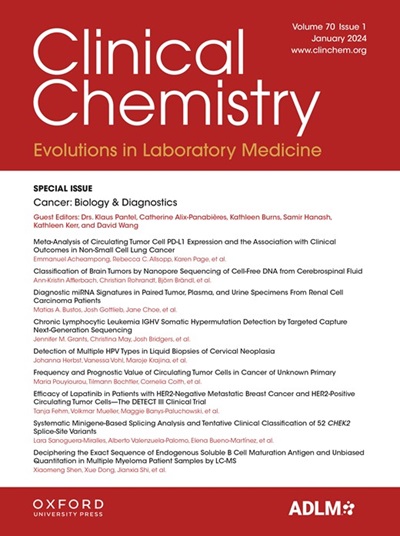A-319 Capillary Blood Collection for Egg-cellent Reproductive Insights
IF 6.3
2区 医学
Q1 MEDICAL LABORATORY TECHNOLOGY
引用次数: 0
Abstract
Background In the United States, an estimated 13% of women between the ages of 15 and 49 years, experience impaired reproductive potential (fecundity). Assessment of fecundity typically requires an in-person physician visit and venous blood collection to evaluate hormone levels and identify potential reproductive health conditions. Exploring less invasive, at-home sampling options could offer couples insights into their personal reproductive abilities, providing peace of mind and aiding in family planning. Methods Capillary blood, obtained using the Tasso®+ capillary blood collection device coupled with a BD Microtainer® serum tube, was utilized for measurements of analytes associated with female fecundity (follicle stimulating hormone, luteinizing hormone, estradiol, progesterone, anti-Müllerian hormone, and prolactin). These are all FDA-approved assays measured on Roche cobas® e801, assay parameters remained unchanged. Professional and self-collected capillary serum samples were acquired in parallel with the standard venous serum samples, to compare clinical equivalency of the capillary sampling option. In addition to isothermal stability studies at room temperature (20-25°C) and refrigerated (2-8°C) conditions, shipping excursion studies based on ISTA 7D recommendations were performed using a novel packaging solution to control sample temperature and thus, specimen integrity. Studies to assess matrix equivalency, linearity, and imprecision of this alternate sample type were also performed to demonstrate analytical performance. Results Method comparison of venous and professional collection of capillary samples demonstrated correlations (R) ≥ 0.9720 with slopes ranging from 0.919 to 0.971 and mean biases within ±8.2% for all analytes (n = 19-79). Self-collected capillary serum samples demonstrated correlations (R) ≥ 0.9827 with slopes that ranged from 0.841 to 0.985 and mean biases within ±10.7% (n = 16-26). Isothermal stability was demonstrated for each analyte up to 7 days at room temperature and refrigerated conditions. Simulated shipping excursion results were found to be acceptable for both winter and summer conditions with mean biases for each analyte within ±10.2% and ±19.2%, respectively. Matrix equivalency, linearity, and imprecision results adhered to current CLIA acceptance limits for each respective measurement. Conclusions The analytical and stability results affirm the feasibility of collecting capillary serum in a patient-centric manner, providing women with relevant information about their reproductive health.A-319 毛细管采血,了解卵子繁殖情况
背景 在美国,估计有 13% 年龄在 15 岁至 49 岁之间的女性的生殖潜能(生育能力)会受到损害。生育力评估通常需要医生亲自到访并采集静脉血,以评估激素水平并确定潜在的生殖健康状况。探索侵入性较小的居家采样方法,可以让夫妇们深入了解个人的生殖能力,让他们安心并有助于计划生育。方法 使用 Tasso®+ 毛细管采血器和 BD Microtainer® 血清管采集毛细管血液,用于测量与女性生育能力相关的分析物(促卵泡激素、黄体生成素、雌二醇、孕酮、抗穆勒氏管激素和催乳素)。这些都是经美国 FDA 批准的检测方法,使用罗氏 cobas® e801 进行检测,检测参数保持不变。在采集标准静脉血清样本的同时,还采集了专业和自采的毛细管血清样本,以比较毛细管采样方法的临床等效性。除了室温(20-25°C)和冷藏(2-8°C)条件下的等温稳定性研究外,还根据 ISTA 7D 建议使用新型包装解决方案进行了运输偏移研究,以控制样本温度,从而保证样本完整性。此外,还进行了基质等效性、线性度和这种替代样本类型的不精密度评估研究,以证明分析性能。结果 对静脉样本和专业人员采集的毛细管样本进行方法比较,结果显示相关性 (R) ≥ 0.9720,斜率范围为 0.919 至 0.971,所有分析物的平均偏差在 ±8.2% 以内(n = 19-79)。自取毛细管血清样本的相关性 (R) ≥ 0.9827,斜率范围为 0.841 至 0.985,平均偏差在 ±10.7% 以内(n = 16-26)。在室温和冷藏条件下,每种分析物的等温稳定性可达 7 天。在冬季和夏季条件下,模拟运输偏差结果均可接受,每种分析物的平均偏差分别在±10.2%和±19.2%以内。基质等效性、线性度和不精密度结果均符合当前 CLIA 对各项测量的接受范围。结论 分析和稳定性结果证实了以患者为中心收集毛细管血清的可行性,为妇女提供了生殖健康的相关信息。
本文章由计算机程序翻译,如有差异,请以英文原文为准。
求助全文
约1分钟内获得全文
求助全文
来源期刊

Clinical chemistry
医学-医学实验技术
CiteScore
11.30
自引率
4.30%
发文量
212
审稿时长
1.7 months
期刊介绍:
Clinical Chemistry is a peer-reviewed scientific journal that is the premier publication for the science and practice of clinical laboratory medicine. It was established in 1955 and is associated with the Association for Diagnostics & Laboratory Medicine (ADLM).
The journal focuses on laboratory diagnosis and management of patients, and has expanded to include other clinical laboratory disciplines such as genomics, hematology, microbiology, and toxicology. It also publishes articles relevant to clinical specialties including cardiology, endocrinology, gastroenterology, genetics, immunology, infectious diseases, maternal-fetal medicine, neurology, nutrition, oncology, and pediatrics.
In addition to original research, editorials, and reviews, Clinical Chemistry features recurring sections such as clinical case studies, perspectives, podcasts, and Q&A articles. It has the highest impact factor among journals of clinical chemistry, laboratory medicine, pathology, analytical chemistry, transfusion medicine, and clinical microbiology.
The journal is indexed in databases such as MEDLINE and Web of Science.
 求助内容:
求助内容: 应助结果提醒方式:
应助结果提醒方式:


